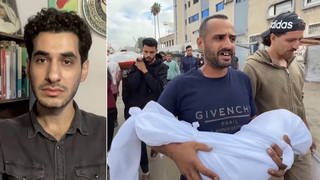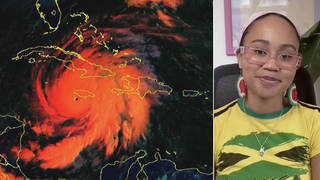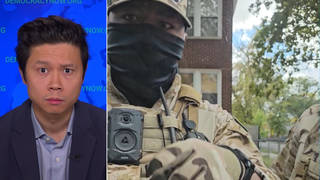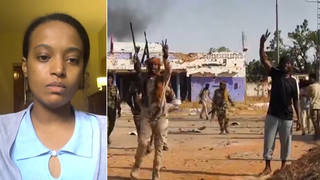
Guests
- Araceli Rodríguezmother of José Antonio Elena Rodríguez
- Taide Elenagrandmother of José Antonio Elena Rodríguez.
Nearly seven years ago, 16-year-old José Antonio Elena Rodríguez was killed in Nogales, Mexico, by U.S. Border Patrol agent Lonnie Swartz, who fired his gun from the U.S. side of the border. The teenager — who was unarmed — died face-down on the sidewalk just a couple of blocks from his home. Border Patrol has for years been plagued with hundreds of allegations of abuse and unnecessary use of deadly force, including the cross-border killings of at least six people on Mexican soil. Most cases are not investigated, and border agents are rarely criminally charged for using violent force. After nearly five years of legal delays, José Antonio’s mother, Araceli Rodríguez, and his grandmother, Taide Elena, brought Lonnie Swartz to trial for second-degree murder in 2017. A Tucson jury acquitted him and were deadlocked on manslaughter charges. In a second trial in November 2018, Swartz was found not guilty of involuntary manslaughter. During Democracy Now!'s trip to the borderlands, we spoke with José Antonio's family, including both Araceli Rodríguez and Taide Elena, at the exact spot where he was gunned down by Swartz. Araceli Rodríguez says, “He was murdered, and there has been no justice. He was killed, and the world is the same. He was murdered, and Border Patrol agent Lonnie Swartz is still free.”
More from this Interview
- Part 1: Justice for José Antonio: Family Demands Accountability for Mexican Teen Killed by U.S. Border Agent
- Part 2: Family of Mexican Teenager Slain by Border Agent Awaits SCOTUS Ruling to Determine If They Can Sue
- Part 3: Border Patrol Has Killed At Least 97 People Since 2003. Hear Some of Their Victims’ Stories
Transcript
AMY GOODMAN: This is Democracy Now!, democracynow.org, The War and Peace Report. I’m Amy Goodman. On Wednesday, Border Patrol agent Jason McGilvray pleaded guilty to a misdemeanor charge for attacking an undocumented immigrant. According to court documents, McGilvray apprehended the man, who has not been named, when he attempted to jump a border fence in Southern California earlier this year. After taking the man into custody, the border agent subsequently punched him in the face. Few details are known about the assault. McGilvray had been a Border Patrol agent since 2006. He resigned as part of his plea agreement and was sentenced to one-year probation. He’s the second border agent to plead guilty to attacking a migrant in just the past few weeks.
Earlier this month, agent Matthew Bowen pleaded guilty to intentionally hitting a Guatemalan migrant with his truck at the U.S.-Mexico border near Nogales, Arizona, in 2017. In a series of racist text messages between Bowen and other Border Patrol agents, Bowen referred to immigrants as, quote, “subhuman,” “mindless murdering savages,” this according to court documents. Bowen, who has also resigned from Border Patrol, will be sentenced in October.
Border Patrol has for years been plagued with hundreds of allegations of abuse and unnecessary use of deadly force, including the cross-border murders of at least six people on Mexican soil. Most cases are not investigated, and border agents are rarely criminally charged for using violent force.
We turn now to an internationally known case that many had hoped would change this pattern of impunity: the death of 16-year-old José Antonio Elena Rodríguez, a teenager from the border town of Nogales, Sonora, Mexico, who was shot to death by U.S. Border Patrol agent Lonnie Swartz through the U.S. border wall on October 10, 2012. José Antonio was walking home in Nogales when Lonnie Swartz began shooting at the teenager down through the border wall from the U.S. side of the border, which stands at least 40 feet above the Mexican side. It’s on a kind of ledge. The agent fired some 16 rounds through the slats of the wall into Mexico, striking José Antonio 10 times in the back and the head. In the midst of the shooting, Lonnie Swartz reloaded his weapon and kept firing. The teenager, who was unarmed, died face-down on the sidewalk just a couple blocks from his home. The border agent alleged the unarmed teenager was throwing rocks at him before the encounter. But even this claim has been disputed.
After José Antonio’s mother, Araceli Rodríguez, and his grandmother, Taide Elena, spent nearly five years fighting for justice, Lonnie Swartz went on trial for second-degree murder in 2017. A Tucson jury acquitted him and were deadlocked on manslaughter charges. In a second trial in November of 2018, Swartz was found not guilty of [involuntary] manslaughter; the jury once again deadlocked on [voluntary] manslaughter charges. Federal prosecutors didn’t pursue a third trial. Lonnie Swartz is on administrative leave, still faces a civil rights lawsuit from the American Civil Liberties Union brought on behalf of José Antonio’s mother Araceli. The lawsuit is currently pending in the U.S. Supreme Court.
Earlier this month, Democracy Now! traveled to the Arizona-Sonora borderlands. In Nogales, Mexico, I interviewed Araceli Rodríguez and Taide Elena at exactly the spot where José Antonio was gunned down nearly seven years ago — José Antonio’s mother and grandmother. I began by asking his mother, Araceli Rodríguez, to describe what happened to her son.
ARACELI RODRÍGUEZ: [translated] He was murdered October 10th, 2012. He was murdered by a Border Patrol agent who shot into Mexico and killed him with 10 bullets on his back.
AMY GOODMAN: How did you hear that he had been killed?
ARACELI RODRÍGUEZ: [translated] My brother-in-law called me on the phone and told me that José Antonio had been murdered.
AMY GOODMAN: Can you tell us about your son?
ARACELI RODRÍGUEZ: [translated] He was a very happy child. He was a good kid. He was a boy who loved his mother. He liked being at home. He liked playing basketball. For me, he was the best. I am his mother. He was a really good boy.
AMY GOODMAN: Can you explain how you understand he died?
ARACELI RODRÍGUEZ: [translated] Everyone knows what happened that day, how José Antonio was killed. He was killed here in front of the border wall. He was walking on the sidewalk. Sometimes repeating this over and over again, explaining what happened, is very painful. He was murdered, and there has been no justice. He was killed, and the world is the same. He was murdered, and Border Patrol agent Lonnie Swartz is still free. He still has a job. It is very hard for me as a mother to remember these moments, to be repeating this story, but we know we have to do it if we ever want justice.
It is so hard as a mother to speak about how my son was murdered on the sidewalk with so many bullets. How is it possible that Lonnie Swartz shot José Antonio in the back 10 times, alleging my son was throwing rocks? As you can see the height of the wall and then you see where José Antonio was killed, it is clear that he was murdered in cold blood. It is so frustrating, and it makes me so angry, knowing that a person can stick his hand in there and kill Mexican children with impunity. Nothing happened to Lonnie Swartz. He’s still free, still has a job and left my family completely destroyed. He left us with a pain in our heart that will last forever.
AMY GOODMAN: The Border Patrol agent said he feared for his life. He would have been standing, oh, 30 feet above your son walking here on the sidewalk. Can you respond to the agent saying he feared for his life?
ARACELI RODRÍGUEZ: [translated] That Lonnie Swartz lied the whole time. He tried to defend something indefensible. There was a video, because there’s a camera right there. There was a video that was allegedly lost where it showed Lonnie Swartz murdering my son. What he says about his life being in danger is not true. Everyone who comes here and sees the height of this wall realizes that Lonnie Swartz was lying about my son throwing rocks. His own co-workers at the trial said that his life was not in danger, that he could have stepped away. It was never proven that José Antonio was throwing rocks.
AMY GOODMAN: Can you describe the trials, the two trials that happened? You decided not to be in the trial for the verdict. Why?
ARACELI RODRÍGUEZ: [translated] Since the beginning, we saw how the judge and the entire jury was on the murderer’s side. They were all American. They were all racist people. The way they saw us was as if we were bugs. They gave us dirty looks. The murderer had a lot of privileges that we never did. He sat there with his water, with his coffee, with his computer, reading books if he wanted to. We weren’t allowed to look at him. We would get in trouble if we looked at him. Lonnie Swartz had so many benefits that we knew what the verdict was going to be. There was a lot of racism. I feel like even the jury was bought. They were all — no offense — gringos. There were all blond, white people, pure Americans. There was not a single Mexican sitting there.
AMY GOODMAN: You came here to the interview with your 15- and 16-year-old daughters. That’s now, in 2019. They were what? Like 8 and 9 years old? How have they been affected by the death of their older brother?
ARACELI RODRÍGUEZ: [translated] My girls were very young. Andrea was around 9 years old, and Taide was probably 8. We were all affected by José Antonio’s death. A lot of people can talk about his death, but they will never feel what a mother feels when their son is ripped away the way my son was. It is a pain, a mark that lasts your entire life. It is something you always think about. You always miss your child. If I see a young man who may be wearing a hat that José Antonio had, I remember him. Seeing a young man wearing a shirt that looked like one José Antonio had, I think it’s him, when I know he is gone. The pain will never go away. Me and my family will always feel that pain.
AMY GOODMAN: What message would you like to leave with the people of the United States about José Antonio, your son?
ARACELI RODRÍGUEZ: [translated] To put themselves in my shoes. People who are fathers and mothers, I think, are the people who may be able to understand. To have your son murdered in the way mine was is a horrific pain that I do not wish upon anyone.
To the jurors, I would ask them: Are you at peace with the decision you made? I would ask them if their conscience is clean with the decision they made. At the trial, they showed them a mannequin representing my son, showing them exactly where the bullets entered his body. He was shot in the head, and Lonnie Swartz continued to shoot him. To the jurors, the judge and the murderer himself, I ask them: How do you sleep at night? How are you at peace with yourself after you murdered my son?
I had hoped that José Antonio’s case would have justice and that it would help stop all of this. How is it possible that Mexican children are being murdered, and the American people don’t do anything? Not even the Mexican people do something, or the Mexican government. For me, both trials were a joke. They just made me angry. One, two very long trials just to declare this man not guilty. In one occasion, I overheard a Border Patrol agent saying that the agency was ready to spend money on five, even 10, trials just like this one.
This is the anger we have. We are also angry at Mexico. Mexico is not strong enough to demand the extradition of this murderer. My son was murdered on Mexican territory, and Lonnie Swartz has to pay. We will not stop fighting. I don’t like to give interviews, but I know I have to. I want José Antonio’s name to be remembered. I want people to know he was murdered by a Border Patrol agent and that nothing was done about it. We need your support. That is why I stand in front of this camera, in front of this mic, demanding justice.
AMY GOODMAN: Araceli Rodríguez, speaking at the exact location where her son, José Antonio, was gunned down by U.S. Border Patrol in 2012 — he on the Mexico side, the border agent on the U.S. side — standing in front of that mural of her son. I also spoke to Taide Elena, José Antonio’s grandmother. His aunt, Gabriela Lopez, translated for her. I asked Taide Elena to tell us about her grandson, José Antonio.
TAIDE ELENA: [translated] Antonio was a boy who was in the middle of high school. He had illusions. He had goals. Like most of the kids from his age, he was a very happy boy. He loved to play basketball. Very well educated, he was a good boy. He didn’t deserve to die like that. Nobody deserves to die like that.
AMY GOODMAN: What did he want to be when he grew up?
TAIDE ELENA: [translated] He wanted to finish high school and turn 18 and join the army. Because I would tell him, “Why do you want to be a soldier?” And he would answer me with another question: “Grandma, and why don’t you like soldiers?” “Because soldiers are trained to kill.” He said, “No, grandma, there’s also good soldiers. Not all are bad. But I want to be there because I want a career. And when I’m finished with my career, I will stop being a soldier, and I will dedicate myself to my career. That is my goal.” That was his goal.
And his biggest dream, illusion, was to ride in a plane. She had told him that she was going to take him to Guadalajara, all three of them, because they were going to make their first communion over there. He wanted to know how it felt to ride in a plane, if he could see the clouds. “You will see the clouds under you,” she would tell him. So, his months were really long, because we were going to leave in March of 2013. And he died October.
AMY GOODMAN: Taide Elena is the grandmother of José Antonio Elena Rodríguez, the 16-year-old Mexican teen who was gunned down by a U.S. border agent in 2012.
When we come back, we continue to speak with Lee Gelernt of the ACLU, who represents the family. We’ll talk to him about the U.S. Supreme Court case that will determine whether his family can sue. The border agent who killed him was acquitted in trial. Stay with us.











Media Options